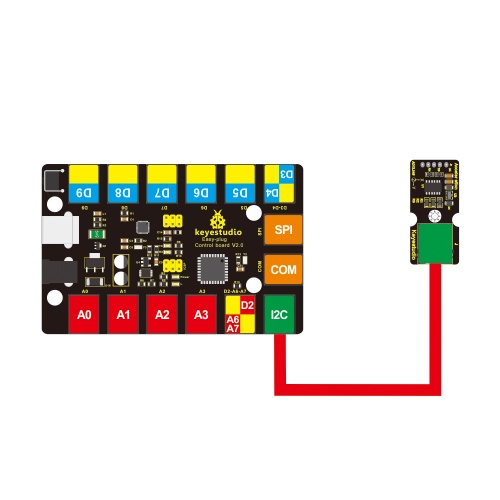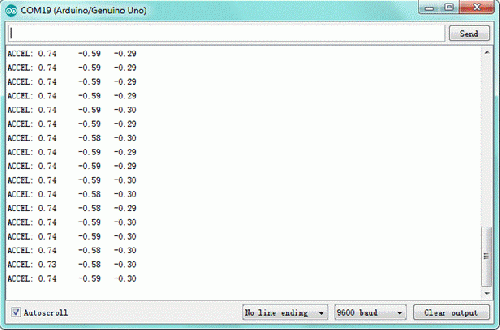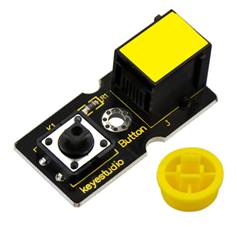Ks0128 keyestudio EASY plug ADXL345 Three Axis Acceleration Module: Difference between revisions
Keyestudio (talk | contribs) |
Keyestudio (talk | contribs) No edit summary |
||
| Line 1: | Line 1: | ||
[[image:ks0112图.jpg|thumb|600px|right|Keyestudio EASY plug ADXL345 Acceleration Module]] | |||
==Introduction== | ==Introduction== | ||
The ADXL345 module is a 3-axis MEMS accelerometer with | The ADXL345 module is a low power, 3-axis MEMS accelerometer with high resolution (13-bit) and measurement at up to ±16g (gravitational force). <br> | ||
Note: this module needs to be used together with EASY plug control board.<br> | Digital output data is formatted as 16-bit twos complement, and is accessible through either a SPI or I2C digital interface.<br> | ||
The ADXL345 is well suited to measures the static acceleration of gravity in tilt-sensing applications, as well as dynamic acceleration resulting from motion or shock.<br> | |||
<span style="color: red">'''Note: '''this module needs to be used together with EASY plug control board.<br> | |||
<br> | |||
==Features== | |||
== | * Connector: Easy plug | ||
* | * Working Voltage: 2.0-3.6V | ||
* 2.0-3. | * Ultra Low Power @2.5v: 40uA /working mode; 0.1uA / standby mode | ||
* Ultra Low Power: 40uA | * Communication interface: I2C / SPI | ||
* Tap/Double Tap Detection | * Tap/Double Tap Detection | ||
* Free-Fall Detection | * Free-Fall Detection | ||
<br> | |||
==Technical Details== | |||
* Dimensions: 41mm*20mm*18mm | |||
* Weight: 4.6g | |||
== | <br> | ||
<br>[[File:ks0128 | ==Connect It Up == | ||
Connect the EASY Plug ADXL345 Acceleration module to control board using an RJ11 cable. Then connect the control board to your PC with a USB cable. | |||
<br>[[File:ks0128.jpg|500px|frameless|thumb]]<br> | |||
<br> | |||
== | ==Upload the Code== | ||
Copy and paste below code to [http://wiki.keyestudio.com/index.php/How_to_Download_Arduino_IDE Arduino IDE] and upload. | |||
<pre> | <pre> | ||
#include <Wire.h> // place file “Wire.h” under the directory “libraries” of Arduino | #include <Wire.h> // place file “Wire.h” under the directory “libraries” of Arduino | ||
// Registers for ADXL345 | // Registers for ADXL345 | ||
#define ADXL345_ADDRESS (0xA6 >> 1) // address for device is 8 bit but shift to the | #define ADXL345_ADDRESS (0xA6 >> 1) // address for device is 8 bit but shift to the | ||
| Line 119: | Line 126: | ||
</pre> | </pre> | ||
<br> | |||
==What You Should See== | |||
Open the Serial monitor to see the 3-axis acceleration data. See changes as you sway the Accelerometer. | |||
<br>[[File:ks0128 Result.gif|500px|frameless|thumb]]<br> | |||
<br> | |||
==Resources == | ==Resources == | ||
'''PDF'''<br> | |||
'''PDF''' | |||
https://drive.google.com/open?id=1Tf19JMZ9C_47d3Gzar8xb766qp5pAFz2 | https://drive.google.com/open?id=1Tf19JMZ9C_47d3Gzar8xb766qp5pAFz2 | ||
<br> | |||
==Buy from == | ==Buy from == | ||
'''Official Website''' | '''Official Website'''<br> | ||
http://www.keyestudio.com/keyestudio-easy-plug-adxl345-three-axis-acceleration-module-for-arduino.html | http://www.keyestudio.com/keyestudio-easy-plug-adxl345-three-axis-acceleration-module-for-arduino.html | ||
[[category:EASY Plug]] | [[category:EASY Plug]] | ||
Revision as of 11:46, 16 November 2018
Introduction
The ADXL345 module is a low power, 3-axis MEMS accelerometer with high resolution (13-bit) and measurement at up to ±16g (gravitational force).
Digital output data is formatted as 16-bit twos complement, and is accessible through either a SPI or I2C digital interface.
The ADXL345 is well suited to measures the static acceleration of gravity in tilt-sensing applications, as well as dynamic acceleration resulting from motion or shock.
Note: this module needs to be used together with EASY plug control board.
Features
- Connector: Easy plug
- Working Voltage: 2.0-3.6V
- Ultra Low Power @2.5v: 40uA /working mode; 0.1uA / standby mode
- Communication interface: I2C / SPI
- Tap/Double Tap Detection
- Free-Fall Detection
Technical Details
- Dimensions: 41mm*20mm*18mm
- Weight: 4.6g
Connect It Up
Connect the EASY Plug ADXL345 Acceleration module to control board using an RJ11 cable. Then connect the control board to your PC with a USB cable.

Upload the Code
Copy and paste below code to Arduino IDE and upload.
#include <Wire.h> // place file “Wire.h” under the directory “libraries” of Arduino
// Registers for ADXL345
#define ADXL345_ADDRESS (0xA6 >> 1) // address for device is 8 bit but shift to the
// right by 1 bit to make it 7 bit because the
// wire library only takes in 7 bit addresses
#define ADXL345_REGISTER_XLSB (0x32)
int accelerometer_data[3];
// void because this only tells the cip to send data to its output register
// writes data to the slave's buffer
void i2c_write(int address, byte reg, byte data) {
// Send output register address
Wire.beginTransmission(address);
// Connect to device
Wire.write(reg);
// Send data
Wire.write(data); //low byte
Wire.endTransmission();
}
// void because using pointers
// microcontroller reads data from the sensor's input register
void i2c_read(int address, byte reg, int count, byte* data) {
// Used to read the number of data received
int i = 0;
// Send input register address
Wire.beginTransmission(address);
// Connect to device
Wire.write(reg);
Wire.endTransmission();
// Connect to device
Wire.beginTransmission(address);
// Request data from slave
// Count stands for number of bytes to request
Wire.requestFrom(address, count);
while(Wire.available()) // slave may send less than requested
{
char c = Wire.read(); // receive a byte as character
data[i] = c;
i++;
}
Wire.endTransmission();
}
void init_adxl345() {
byte data = 0;
i2c_write(ADXL345_ADDRESS, 0x31, 0x0B); // 13-bit mode +_ 16g
i2c_write(ADXL345_ADDRESS, 0x2D, 0x08); // Power register
i2c_write(ADXL345_ADDRESS, 0x1E, 0x00); // x
i2c_write(ADXL345_ADDRESS, 0x1F, 0x00); // Y
i2c_write(ADXL345_ADDRESS, 0x20, 0x05); // Z
// Check to see if it worked!
i2c_read(ADXL345_ADDRESS, 0X00, 1, &data);
if(data==0xE5)
Serial.println("it work Success");
else
Serial.println("it work Fail");
}
void read_adxl345() {
byte bytes[6];
memset(bytes,0,6);
// Read 6 bytes from the ADXL345
i2c_read(ADXL345_ADDRESS, ADXL345_REGISTER_XLSB, 6, bytes);
// Unpack data
for (int i=0;i<3;++i) {
accelerometer_data[i] = (int)bytes[2*i] + (((int)bytes[2*i + 1]) << 8);
}
}
// initialise and start everything
void setup() {
Wire.begin();
Serial.begin(9600);
for(int i=0; i<3; ++i) {
accelerometer_data[i] = 0;
}
init_adxl345();
}
void loop() {
read_adxl345();
Serial.print("ACCEL: ");
Serial.print(float(accelerometer_data[0])*3.9/1000);//3.9mg/LSB scale factor in 13-bit mode
Serial.print("\t");
Serial.print(float(accelerometer_data[1])*3.9/1000);
Serial.print("\t");
Serial.print(float(accelerometer_data[2])*3.9/1000);
Serial.print("\n");
delay(100);
}
What You Should See
Open the Serial monitor to see the 3-axis acceleration data. See changes as you sway the Accelerometer.

Resources
PDF
https://drive.google.com/open?id=1Tf19JMZ9C_47d3Gzar8xb766qp5pAFz2
Buy from
Official Website
http://www.keyestudio.com/keyestudio-easy-plug-adxl345-three-axis-acceleration-module-for-arduino.html
